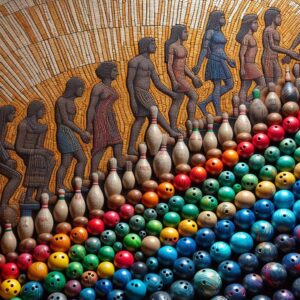Bowling is a popular sport that people of all ages enjoy across the world. The smooth, polished wooden or synthetic lanes allow bowlers to roll balls at high speeds to knock down pins.
However, not all bowling lanes are made equal. The type of lane material and oil conditions have a significant impact on ball motion and bowling strategy.
This beginner’s guide will teach you about common bowling lane types, oil patterns, and how to read lane conditions. With this knowledge, you can better adjust your throw to match the lane surface. We’ll also cover professional lane maintenance that ensures a consistent bowling experience. Let’s get rolling!
What is a Bowling Lane?
Before diving into lane types and conditions, it helps to understand what makes up a regulation bowling lane.
The dimensions of a standard bowling lane are 60 feet from the foul line to the headpin. The lane is 41.5 inches wide and bordered by gutters that collect gutter balls.
Bowling lanes consist of narrow wooden boards running lengthwise, overlaid with synthetic lane materials. Common surfaces are maple, pine, laminates, and layered synthetic polymers.
Under the lane is the wood subsurface that provides structure. Beneath this are steel cables and suspension systems that allow the lane to flex and absorb ball impacts.
Lane markings indicate the foul line, arrows, dots, and pin deck. Built-in sensors detect pin falls and fouls electronically. Modern scoring systems connect to monitors above each lane.
The lane’s flat, smooth surface allows the ball to roll true and straight. However, subtle differences in friction and oil patterns affect ball motion. Understanding these elements helps bowlers optimize their delivery.
Now that you know the basic anatomy of a regulation bowling lane, let’s examine how lane types, oil patterns, and maintenance affect your game. Subtle variations make every lane a new puzzle to solve!
Common Bowling Lane Types
The first key factor influencing ball motion is the lane material itself. While wooden lanes used to be standard, many modern bowling centers now use synthetic materials.
Wooden Bowling Lanes
The traditional bowling lane consists of narrow wooden boards laid end-to-end. Hardwood maple is most common, though some lanes may use softer pine.
Pros:
- Natural, traditional feel
- Provides good traction with a bit of slide
Cons:
- Can warp and deform over time
- More expensive to maintain
- Prone to damage from bowling balls
Wood was the standard for decades, but the cost and upkeep of real wood lanes has caused many alleys to switch to synthetic materials.
Synthetic Bowling Lanes
Modern lanes use synthetic materials layered over the wood subsurface. Two common types are:
Polymer Layered Lanes: Multiple layers of high-tech polymer resins coated on plywood. This creates a smooth surface that’s durable and consistent.
Laminated Lanes: These fuse a synthetic laminate material directly to the wood. The laminate incorporates artificial designs to mimic wood grain.
Pros of Synthetics:
- Consistent surface and ball roll
- Stands up well to heavy bowling use
- Easier and cheaper to maintain
Cons:
- Lacks the classic style of real wood lanes
Well-kept synthetic lanes provide reliable ball control and longevity. That makes them a popular choice for heavily used public bowling centers.
Lane Surface Prep and Oil Patterns
The next key factor affecting bowling is the oil applied to lanes to protect them during games. This oil allows the ball to slide smoothly before the roll. However, not all lane patterns are equal.
Understanding oil patterns allows a bowler to choose where to roll the ball. The heads of lanes tend to be drier, while the middles are more oily. The oil carries down the lane on every throw.
Light, Medium, and Heavy Oil Conditions
Bowling lanes can be oiled to different levels for various effects:
Light Oil: Just 6-9 milliliters applied from side to side. Minimal oil stays in the middle. Requires more hook power from the bowler.
Medium Oil: 10-20 milliliters applied from side to side. Drier at the start, wetter in the mid-lane. Allows combo of speed and hook.
Heavy Oil: 20+ milliliters applied from side to side. Lots of oil stays on the boards. Requires bowlers throw straight and stay inside the oil line.
Understanding lane oil levels helps choose the best ball, speed, and hook angle. Heavily oiled lanes demand straight power, while drier lanes allow more hook room.
Dry Lanes and Optimal Strategies
In open bowling, lanes tend to get drier over the day as oil gets pushed down. This makes the heads and middles increasingly dry.
On dry lanes, using shiny or pearlized reactive resin balls allows a strong hook motion from the friction. Moving left of center and playing cross lane can help find oil and avoid over-hooking directly up the dry gutters.
Professional tournaments actually strip off oil completely to create ultra-dry lane challenges during televised matches. Bowlers use urethane plastic balls on dry lanes to get a predictable roll.
How Lanes Breakdown During Bowling
As the games progress, bowling balls lay oil down toward the pins while the heads get depleted. This makes the ideal line shift deeper into the lane over time.
In open bowling, aim for the dry outside early on. As that breaks down, move inward to take advantage of the oil pushed to the middle.
During league and tournament play, the heads tend to burn up quickly. Switch to heavier oil balls drilled for mid-lane and back-end motion. Stay ahead of the transition.
Reading Lane Conditions
Recognizing oil patterns visually takes practice. Watch how your ball and other bowlers’ balls react to judge relative oil levels in different parts of the lane.
Signs of an Oily Lane
- Ball skids far before hooking
- Weak hook with plastic or urethane balls
- Can play deep inside lines with control
- Oil rings visible on ball at impact
Signs of a Dry Lane
- The ball hooks early and sharply
- Overhooks into the gutter if thrown too slow
- Cannot play the deep inside line
- Requires surface or pearlized reactive balls
- Leave many split spares from overhooking
Subtle differences in slide and delay before the hook point tell an experienced bowler if they should move left or right. Don’t be afraid to ask the alley staff about the oil pattern too.
Using Lane Position to Your Advantage
Lane position also influences ball reaction. The low friction gutters on the outsides generate more hook. The higher oil concentration in the middle keeps the balls straight.
When lanes are heavily oiled, playing up the 10 board or even closer to the center dots allows keeping the ball in the oil for control.
On drier lane patterns, starting on the outside 5 board or further left gives room for the big sweeping hook many bowlers prefer.
Identify where the friction and oil meet between the heads and mid-lane. Adjust lateral position and angle to use both to your advantage.
Professional Lane Maintenance
To maintain fair and consistent bowling conditions, professional mechanics carefully oil and maintain lanes using precision machines.
Lane Oiling Machines
Large mechanical lane oilers have programmable settings for oil viscosity, volume, and board-by-board patterns. Some agitate the oil for even application across the lane.
Staff program oil patterns based on the type of bowling and lane surfaces. Heavier patterns for tournaments, lighter for open bowling.
Applying lane oil is a science. Too much oil and balls slide wildly. Too little and dry lanes cause ugly splits. Consistency matters across lanes.
Cleaning and Resurfacing Lanes
Besides oiling, bowling centers regularly clean and resurface lanes to maintain proper ball roll.
Lane cleaners use detergents to break up oil residue and grime. They also have a mild abrasive to lightly sand and refresh the lane surface.
Lanes also periodically get fully resurfaced. This removes the top plastic-like layer to eliminate scratches and damage from bowling balls. A new coating is then applied.
Following standards and protocols from industry groups helps ensure fair and compliant lane conditions.
The Bottom Line
Understanding lane engineering and oil patterns unlocks the secrets of bowling success. Match your equipment, speed, and spin to the lane surface for the best accuracy.
Wood or synthetic construction provides the right combination of slide and grip. Lane oil patterns challenge bowlers to play different lines. Reading oil transition allows adjusting position as the lane breaks down.
With practice, bowlers can learn to recognize oily and dry conditions instantly. They can then tweak speed, angle, and ball choice to match. Both recreational and professional bowling succeeds when the lanes are clean, conditioned, and consistent.
Now you know the basics of lane types, oil patterns, and maintenance. Use these tips to unleash your bowling potential and roll more strikes on any lane surface!
Frequently Asked Questions
What is a bowling lane called?
A bowling lane is often referred to as a lane or alley. The playing surface itself made of wood or synthetics is called the lane.
Why are bowling lanes so strong?
Bowling lanes need to be extremely strong and durable to withstand the impact of heavy balls rolling down at high speeds over decades of use. They use hardwoods like maple mounted on shock-absorbing supports and steel cables. Modern lanes also have synthetic overlays that create a smooth, resilient surface.
How many people can be on a bowling lane?
Most bowling lanes accommodate up to 6 players per lane. However, rules vary by bowling center, with some allowing up to 8 players if facilities permit. Too many players can lead to crowding and delays between turns.
What is lane etiquette in bowling?
Lane etiquette includes only walking on the approach to throw your ball, staying off the lane surface. Only one player should be bowling at a time per lane. Bowlers should wait for lane sweepers to reset pins before throwing. Players should allow faster groups to play through if falling behind pace.
What is the end of a bowling lane called?
The end of the bowling lane containing the pins is called the pin deck. This raised wooden area is about 15 feet long. Pins are set in specific spots on the pin deck by automated machines.
What is Rule 31 in bowling?
Rule 31 refers to a foul line violation. Stepping over the foul line during a throw is a rule 31 foul. This results in that throw being marked zero. Foul detectors now automate this rule.
Can you be naturally good at bowling?
Some natural athleticism and hand-eye coordination can make bowling easier for some people. But bowling skill mainly comes from understanding lane conditions, choosing the right ball, and practicing proper technique. Lessons and coaching are recommended to bowl consistently well.
How do bowling lanes not get damaged?
Regular cleaning, oiling, and resurfacing of lanes protects them from ball damage. The flexibility from cables and supports also allows absorbing impact without warping. Still, lanes do suffer normal wear and tear over decades and need periodic refinishing.
Why do they oil bowling lanes?
Oiling lanes allows bowling balls to slide smoothly before hooking into the pins. Oil protects the wood from drying out. Different oil patterns change ball reaction, providing an added challenge. Lane oil is carefully applied to ensure fair conditions.





